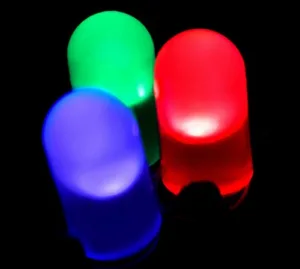Why are blue LEDs so difficult to make? It is a question that has dogged the field since the devices’ commercialisation in the 1990s, and has now been answered by scientists at University College London (UCL), the University of Bath and Daresbury Laboratory.
LEDs are formed from two layers of semiconducting materials: one has mobile negative charges, or electrons, available for conduction, and the other has positive charges, or holes. An electron and a hole can meet at the junction between the two when a charge is applied, emitting a photon (light particle).
To grow a semiconductor layer, a crystalline film of a specific material is grown and modified by doping (adding small amounts of an ‘impurity’ element, which has more or fewer electrons taking part in the chemical bonding). These impurities donate an extra positive or negative charge to the material, depending on the number of electrons.
Blue LEDs use gallium nitiride (GaN), which has a large energy separation (or gap) between electrons and holes. The gap is important when tuning the energy of emitted photos to produce blue light. However, while doping for negative charges is easy, doping for positive charges has not been possible. A breakthrough was made by doping the GaN with a large amount of magnesium, and the researchers delved down to the atomic level to understand what had happened.
John Buckeridge of UCL said, “[B]ased on what is seen in other common semiconductors such as silicon, you would expect each magnesium atom added to the crystal to donate one hole. But in fact, to donate a single mobile hole in gallium nitride, at least a hundred atoms of magnesium have to be added. It’s technically extremely difficult to manufacture gallium nitride crystals with so much magnesium in them”.
The source of the problem was discovered by examining the unusual behaviour of doped GaN at the atomic level, with computer simulations using hybrid quantum and molecular modelling.
“The simulation tells us that when you add a magnesium atom, it replaces a gallium atom but does not donate the positive charge to the material, instead keeping it to itself”, said UCL’s Richard Catlow, one of the study’s co-authors. “In fact, to provide enough energy to release the charge will require heating the material beyond its melting point. Even if it were released, it would knock an atom of nitrogen out of the crystal, and get trapped anyway in the resulting vacancy. Our simulation shows that the behaviour of the semiconductor is much more complex than previously imagined, and finally explains why we need so much magnesium to make blue LEDs successfully.

